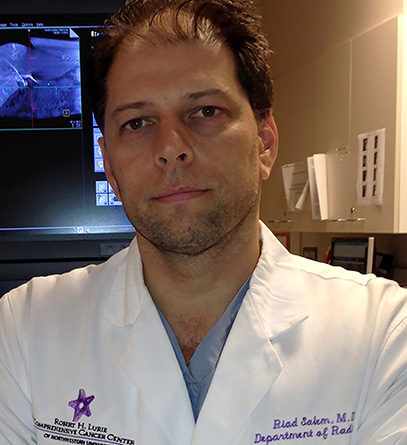Yttrium-90 Therapy Developed at Northwestern Has Become Standard of Care
In 2021 the U.S. Food and Drug Administration (FDA) approved the use of the Yttrium-90 (Y-90) Glass Microspheres (TheraSphere™, Boston Scientific, Marlborough, MA, USA) for the treatment of patients with hepatocellular carcinoma (HCC). This was followed in 2022 by the recognition of this therapy in the Barcelona Clinic Liver Cancer (BCLC) HCC treatment paradigm. These events elevated this cutting edge technology to a standard of care treatment option for patients with HCC. Northwestern faculty Riad Salem, M.D. and Robert Lewandowski, M.D. were critical in these developments.
Liver cancer is one of the most common cancers globally, and HCC is the most common type of primary liver cancer. Until the development of the Y-90-based microspheres, the primary ways to treat HCC were surgery, including liver transplantation, local therapies such as chemoembolization, and more recently, systemic therapies.
Dr. Lewandowski said, “Dr. Salem and I have worked for over 20 years to get transarterial radioembolization (TARE) with Y-90 approved by the FDA and then develop, refine and optimize this therapy and this medical device. We did it within a multi-disciplinary team at Northwestern, including colleagues in hepatology, medical oncology and transplant surgery.”
Dr. Salem was the principal investigator of Boston Scientific’s LEGACY trial, the pivotal study that resulted in the acceptance of TARE by both the FDA and BCLC guidelines. Dr. Salem and Dr. Lewandowski collaborated with colleagues at Mount Sinai (NY, NY) and the University of Washington (Seattle, WA) to perform their study.
Dr. Salem said, “One of the things we’ve been working on for 20 years is novel ways to get therapies through the FDA. The FDA is very careful about the proper pathway for treatments and devices to reach the market. With LEGACY, the team found a novel pathway for full FDA approval. It was also the first device to receive FDA approval in the HCC space. Part of the success and payoff of over 20 years of work, is that TARE is now the most common treatment in the U.S. for patients prior to liver transplant. It has surpassed all the other treatments that had previously been standard of care for HCC.”
Another achievement by the LEGACY team is that the TheraSphere™ device now serves as a predicate device. A predicate device makes it easier for other devices to receive FDA approval if they’re similar to the first device. Dr. Riad’s team set the blueprint for what kind of data must be generated for an FDA application for similar technology.
The Y-90 therapy was developed for the liver, but the same technology is now being used in other organs. Northwestern has done the first-in-human brain study and they’re doing first-in-human prostate and spleen studies as well. Drs. Salem and Lewandowski and their teams continue to innovate with this device.
Dr. Lewandowski received an R01 for an observational study of this treatment. He said, “The NIH funding I received is for using Y-90 in a novel way, with the goal of converting non-operative patients into surgical candidates by improving surgical margins and increasing future liver remnant volumes.”
The two stressed the importance of trainees in developing this technology. Trainees have contributed significantly to the TARE program, and in turn, they have received many opportunities to grow their expertise as researchers. At Northwestern, our trainees regularly contribute to our publications, of which many have been first authors, and they are encouraged to give scientific presentations at national meetings. Northwestern’s support of its IR trainees, as well as the chance to learn from Drs. Salem and Lewandowski are likely why many have come to Northwestern for Interventional Radiology over the last 20 years.
Dr. Salem added, “We have always taken on students and residents, offering our mentorship. Dr. Lewandowski and I started working together almost 25 years ago when he was a first-year radiology resident, and here we are 25 years later. We’ve always taken this formula of working with students and residents and training them and now, in our section, our last several hires are people we’ve worked with, researched with, collaborated with and now they're our partners. So, it’s a good formula.”

